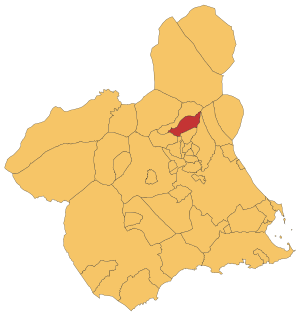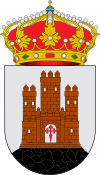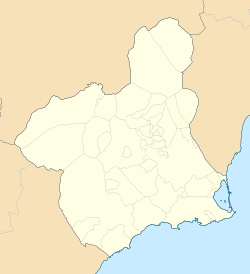Blanca, Murcia facts for kids
Quick facts for kids
Blanca
|
|||
|---|---|---|---|
 |
|||
|
|||

Location in Murcia
|
|||
| Country | |||
| Autonomous community | |||
| Province | |||
| Comarca | Vega Alta del Segura | ||
| Judicial district | Cieza | ||
| Area | |||
| • Total | 87.7 km2 (33.9 sq mi) | ||
| Elevation | 233 m (764 ft) | ||
| Population
(2018)
|
|||
| • Total | 6,564 | ||
| • Density | 74.85/km2 (193.85/sq mi) | ||
| Demonym(s) | Blanqueños | ||
Blanca is a charming town in the Region of Murcia, Spain. It is part of the "Vega Alta del Segura" area. This town is one of six special places in the Ricote Valley. Other towns in the valley include Abarán, Ojós, Ricote, Ulea, Archena, and Villanueva de Segura.
Blanca is surrounded by other towns. To the north is Abarán, and to the south are Ulea and Ojós. Molina de Segura and Fortuna are to the east, while Ricote is to the west. Blanca covers an area of 87.7 square kilometers (about 33.8 square miles). It sits at an average height of 233 meters (764 feet) above sea level. In 2011, about 6,489 people lived in Blanca.
Contents
Getting to Blanca: Roads and Connections
Blanca is easy to reach by road. The main highway nearby is the A-30, which connects Albacete and Murcia.
Travel from Major Cities
- If you are coming from Murcia, take the A-30 highway. Look for Exit 111, which is marked "Blanca-ffcc rail station."
- From Madrid, you can use Exit 110 on the A-30 highway. Another option is the main road N-301.
- If you are traveling from Valencia, you can connect to the A-30 from the new A-33 highway. The main road N-344 is also an option.
Blanca's Rich History
Blanca has a very long and interesting history. People lived here even before the Muslim era. At one point, it was a safe place for wounded soldiers, orphans, and widows. This was true no matter their religion or where they came from. Even the Vatican confirmed this special status.
Early Beginnings and the "Wolf King"
Permanent human presence in Blanca dates back to the year 713. This was when the Arab conquest arrived. You can still see parts of its old castle, which was built in the 12th century.
In the 13th century, the town was known as "Negra." This name likely came from the black mountain near the castle. The castle itself was built between 1155 and 1171. It was built by the first King of Murcia, Muhammad ibn Mardanis, also known as the "Wolf King."
Changes and Challenges
In 1228, Blanca became part of the Ricote Valley. This happened during a rebellion led by Ibn Hud against the Almohads. After his death, the region faced a period of disorder. In 1243, an agreement called the Alcaraz Pact was signed with Castile. This made the region a protectorate of the Castilian Crown. It promised to respect Muslim traditions in exchange for loyalty to the Castilian king.
However, King Alfonso X later broke some parts of this agreement. This led to a rebellion by the local Muslim population between 1264 and 1266. After the rebellion was stopped, Alfonso X placed the Ricote Valley under the control of the city of Murcia.
The Order of Santiago and a New Name
Later, there was a struggle over who would be the next king of Castile. Sancho IV, who would become king, promised to reward a powerful group called the Order of Santiago. He said he would give them the Ricote Valley, including Negra (Blanca), if they helped him. When Sancho IV became king in 1285, he kept his promise.
Peace did not last long. In 1296, James II of Aragón invaded the Kingdom of Murcia. Negra and its castle were given to a counselor named Bernardo de Sarria.
The name "Negra" was last used in a document in 1315. The town's name likely changed to "Blanca" between 1353 and 1362. This was probably due to the influence of Dona Blanca de Borbón, the Queen of Castile. She was supported by leaders of the Order of Santiago. In 1382, the name "Blanca" appeared for the first time in a document.
Population Shifts and New Laws
The 15th century was a difficult time for Blanca. People sometimes had to leave their homes due to conflicts. After a difficult event in Cieza in 1477, Blanca's inhabitants left again. They returned in 1492 after the Kingdom of Granada was conquered.
The Order of Santiago controlled Blanca until the 19th century. To improve their lands, the Order encouraged Muslims in Blanca to convert to Christianity. Those who converted were called "new Christians" or "Moriscos." In 1507, churches were built on old mosques. Many Moriscos hoped conversion would ease their tax burdens, but it did not. This led to a rebellion in 1517, which was put down.
Growth and Challenges in Later Centuries
In the 16th century, Blanca's population grew a lot. In 1591, King Philip II, who needed money for his wars, allowed Blanca to become its own municipality. This cost the town 2,400 ducats.
However, in 1613, Philip III ordered the expulsion of the Moriscos from the Ricote Valley. This caused great hardship for Blanca, leaving only about 300 people. But, 10-15 years later, about 45% of its former residents returned.
The famous writer Miguel de Cervantes Saavedra wrote about the Moriscos of the Ricote Valley. He featured a character named Morisco Ricote. Some experts believe this character was inspired by people from the Ricote Valley.
In the 18th century, Blanca began to recover. Its population grew from 700 in 1713 to 1,378 in 1786. The current church, dedicated to St. John the Evangelist, was rebuilt around this time. It was finished in 1717.
Modern Times and Community Spirit
After the War of Independence (1808-1814), King Ferdinand VII confirmed Blanca's status as a municipality in 1819. In 1828, Blanca was chosen as a safe place during a yellow fever outbreak. According to tradition, the town was spared from the disease through the prayers to St. Roch, who became Blanca's patron saint.
In 1851, Blanca gained independence from the Order of Santiago. The town began to prepare for the new century. In 1856, a new bridge was built over the River Segura. A road connecting the town to the railway station was finished in 1869. Public lighting was installed in 1894.
Also in 1894, Blanca suffered from landslides that destroyed several buildings. This changed the landscape and led to the construction of new houses and streets.
During the 20th century, Blanca experienced political and social changes, like the rest of Spain. There were times of unrest and protests. Despite these challenges, Blanca remained relatively far from the front lines during the Spanish Civil War (1936-1939).
From a population standpoint, the 20th century was a time of stagnation for Blanca. It had about 6,000 inhabitants a century ago, and it still has a similar number today. Immigration is now important to help the population grow.
The town's economy used to rely on agriculture, esparto grass, and timber. However, these industries declined. Many people had to move away for work. Today, agriculture, especially fruit and grapes, has improved thanks to water from the Tajo-Segura river. Blanca's people continue to work hard to develop their town.
Places to See in Blanca
Blanca has many interesting sights for visitors.
- Church St. John the Evangelist: A beautiful church from the 18th century.
- Moorish Castle: An ancient castle dating back to the 12th century.
- Peña Negra: A unique black volcanic rock formation where the town sits.
- Blanca Museum and Art Center (MUCAB): A modern building known for its architecture.
- Pedro Cano's Foundation: A place dedicated to the art of Pedro Cano.
- Centro Negra: A space for art research and creation (AADK).
- Interpretation Centre of Water and Light: Learn about the importance of water and light in the region.
- Hermitage of Saint Roch: A Baroque-style chapel.
- Holy Family Chapel: Another peaceful chapel.
- Hermitage of San Pedro: A small chapel dedicated to Saint Peter.
- Church "Virgen del Pilar": A church named after the Virgin of Pilar.
- Ferris Wheel "Núñez Miguelico": A fun attraction.
- Craftsman House Workshop "Center Negra": Located near the Moorish castle, offering art courses.
- Country house "La Favorita": A historic country house.
- Walkways along the river: Enjoy peaceful walks along the Segura River.
Blanca's Economy
Blanca has two main industrial areas:
- Industrial Estate "San Roque"
- Industrial Estate "Ángel Prieto Oliva"
Festivities and Important Events
Blanca celebrates several lively festivals throughout the year.
Easter Festivities
During Lent, religious groups (called cofradías and brotherhoods) prepare for Easter. They hold parades and events filled with devotion. Blanca has eight religious groups. The oldest ones include:
- The Royal and Most Illustrious Brotherhood of Our Father Jesus of Nazareth
- The Brotherhood of St. John the Evangelist
- The Royal Congregation of the Sacred Hearts of Jesus and Mary
- The Brotherhood of Servitas of Our Lady of the Virgin of Sorrows
Newer groups include:
- The Brotherhood of Veronica
- The Brotherhood of San Pedro
- The Brotherhood of St Mary Magdalene
- The Brotherhood of the Agony in the Garden
A special tradition is the "Bid of Images." People show their emotion by paying to carry the chosen religious image on their shoulders during processions.
Summer Festivities
In August, Blanca celebrates its summer festivities in honor of its patron, Saint Roch. These celebrations are known for sweet bread (la mona) and bull running.
The bull running in Blanca is very famous. It has been declared a "Regional Tourist Interest." This tradition is over 350 years old and is unique in the Region of Murcia. The atmosphere during the bull running is full of joy. There is dancing and music from bands, and everyone is welcome. It always takes place before August 15th.
Spring Festivities
After Easter, Blanca celebrates a week of festivities dedicated to Saint Roch. The most important parts of these celebrations are the Coronation of the Queen and the Pilgrimage. During the pilgrimage, the statue of the patron saint is carried from the church in the town center back to his own chapel. People welcome the saint with cheers and fireworks.
Twin Towns
Blanca has a special connection with another town.
Twinning means connecting two towns and cultures. It helps people share customs, build relationships, and create friendships. In the late 20th century, Blanca decided to twin with Anguillara Sabazia, an Italian town near Rome.
These two towns are similar in many ways. They have similar structures, climates, and the importance of water. Anguillara has a lake (Bracciano), and Blanca has a river (Segura). The twinning began in August 1998 when a group from Anguillara visited Blanca. In May 1998, 55 people from Blanca traveled to Italy to visit Anguillara and strengthen their bond.
See also
 In Spanish: Blanca (Murcia) para niños
In Spanish: Blanca (Murcia) para niños





